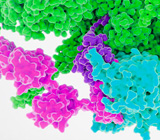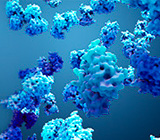-
REAGENT SERVICES
Hot!
-
Most Popular Services
-
Molecular Biology
-
Recombinant Antibody/Protein
-
Reagent Antibody
-
CRISPR Gene Editing
-
DNA Mutant Library
-
IVT RNA and LNP Formulations
-
Oligo Synthesis
-
Peptides
-
Cell Engineering
-
- CRISPR/Cas9 sgRNA
- CRISPR/Cas12a crRNA
- Prime Editing Guide RNA
- Base Editing Guide RNA
- HDR Templates
- gRNA + HDR Template Design Tools
- cGMP Guide RNA
- cGMP HDR Templates
- CRISPR/Cas Proteins
- CAR-T Knock-in Optimization Kit
- CRISPR Plasmids
- CRISPR gRNA Plasmid Libraries
- CRISPR Cell Lines
- Microbial Genome Editing
-
-
PRODUCTS
-
Most Popular Reagents
-
 Instruments
Instruments
-
Antibodies
-
ELISA Kits
-
Protein Electrophoresis and Blotting
-
Protein and Antibody Purification
-
Recombinant Proteins
-
Molecular Biology
-
Stable Cell Lines
-
Cell Isolation and Activation
-
 IVD Raw Materials
IVD Raw Materials
-
 Therapy Applications
Therapy Applications
-
Resources
-
- Pharmacokinetics and Immunogenecity ELISA Kits
- Viral Titration QC ELISA Kits
- -- Lentivirus Titer p24 ELISA KitHot!
- -- MuLV Titer p30 ELISA KitNew!
- -- AAV2 and AAVX Titer Capsid ELISA Kits
- Impurity Test ELISA Kits
- -- BSA ELISA Kit, 2G
- -- Cas9 ELISA KitNew!
- -- Protein A ELISA KitNew!
- -- His tagged protein detection & purification
- -- dsRNA ELISA Kit
- -- Endonuclease ELISA Kit
- COVID-19 Detection cPass™ Technology Kits
-
- Automated Maxi-Plasmid PurificationHot!
- Automated Mini-Plasmid PurificationNew!
- PCR Reagents
- S.marcescens Nuclease Benz-Neburase™
- DNA Assembly GenBuilder™
- Cas9 / Cas12a / Cas13a Nucleases
- Base and Prime Editing Nucleases
- GMP Cas9 Nucleases
- CRISPR sgRNA Synthesis
- HDR Knock-in Template
- CRISPR Gene Editing Kits and Antibodies
-
![AmMag™ Quatro Automated Plasmid Purification]() AmMag™ Quatro automated plasmid purification
AmMag™ Quatro automated plasmid purification
-
![Anti-Camelid VHH]() MonoRab™ Anti-VHH Antibodies
MonoRab™ Anti-VHH Antibodies
-
![ELISA Kits]() ELISA Kits
ELISA Kits
-
![Precast Gels]() SurePAGE™ Precast Gels
SurePAGE™ Precast Gels
-
![Quatro ProAb Automated Protein and Antibody Purification System]() AmMag™ Quatro ProAb Automated Protein and Antibody Purification System
AmMag™ Quatro ProAb Automated Protein and Antibody Purification System
-
![Target Proteins]() Target Proteins
Target Proteins
-
![AmMag™ Quatro Automated Plasmid Purification]() AmMag™ Quatro automated plasmid purification
AmMag™ Quatro automated plasmid purification
-
![Stable Cell Lines]() Stable Cell Lines
Stable Cell Lines
-
![Cell Isolation and Activation]() Cell Isolation and Activation
Cell Isolation and Activation
-
 IVD Raw Materials
IVD Raw Materials
-
![Quick
Order]() Quick Order
Quick Order
-
![Quick
Order]() Quick Order
Quick Order
- APPLICATIONS
- RESOURCES
- ABOUT US
- SIGN IN My Account SIGN OUT
- REGISTER

![Amino Acid Code Amino Acid Code]()
Biology Terms Dictionary
This Biology terms dictionary provides query services for biology and biochemistry terms. Please enter the biology or biochemistry terms you want to search.
List by Alphabet: A B C D E F G H I J K L M N O P Q R S T U V W X Y Z
Pharmacokinetic Study
Introduction
A pharmacokinetic (PK) study evaluates how a drug is absorbed, distributed, metabolized, and excreted (ADME) in the body. It provides critical information about the time-course of drug concentration in biological matrices, informing dosage regimens, efficacy, and safety profiles. PK studies are essential for drug development, ensuring that a therapeutic achieves optimal systemic exposure with minimal toxicity.
Key Parameters in PK Studies
- Absorption: Describes how a drug enters systemic circulation following administration.
- C_max: Maximum plasma concentration.
- T_max: Time to reach C_max.
- Bioavailability (F): Fraction of the administered dose that reaches systemic circulation.
- Distribution: Examines how a drug disperses into tissues and organs after absorption.
- Volume of distribution (Vd): Indicates the extent of drug distribution relative to plasma.
- Tissue-specific drug concentrations.
- Metabolism: Studies the enzymatic conversion of the drug into active or inactive metabolites, primarily in the liver.
- Identification of metabolites and metabolic pathways.
- Enzyme kinetics (e.g., cytochrome P450 activity).
- Excretion: Analyzes how the drug and its metabolites are eliminated, typically via renal or hepatic routes.
- Clearance (CL): Rate of drug elimination from plasma.
- Half-life (T½): Time required for plasma concentration to decrease by 50%.
- Systemic Exposure: Represents the total drug exposure over time.
- Area Under the Curve (AUC): Integral of plasma concentration vs. time curve.
Types of PK Studies
- Single-Dose Studies: Evaluate the pharmacokinetics of a drug following a single administration. Determines initial parameters like C_max, T_max, and T½.
- Multiple-Dose Studies: Analyze steady-state pharmacokinetics under repeated dosing conditions. Assess accumulation and time to steady state.
- Comparative Studies: Compare pharmacokinetics of different formulations, routes of administration, or populations. Critical for bioequivalence studies.
- Population PK Studies: Investigate pharmacokinetic variability in diverse patient groups (e.g., age, gender, genetic differences, disease states).
Methodology of PK Studies
- Study Design: Select dosing regimen (single vs. multiple doses) and administration route (oral, IV, subcutaneous). Randomized, crossover, or parallel designs may be used.
- Sampling: Blood, plasma, urine, or tissue samples are collected at predefined intervals. Sampling frequency depends on the drug's expected half-life and pharmacokinetic profile.
- Analytical Techniques:
- Liquid Chromatography-Mass Spectrometry (LC-MS): Gold standard for quantifying drug and metabolite concentrations.
- Enzyme-Linked Immunosorbent Assay (ELISA): Common for monoclonal antibodies or biologics.
- Data Analysis:
- Non-compartmental Analysis (NCA): Direct calculation of PK metrics like AUC and T½ without assuming a specific compartmental model.
- Compartmental Analysis: Models drug distribution and elimination using mathematical compartments (e.g., one- or two-compartment models).
Applications of PK Studies
- Drug Development: Optimize dosage forms, routes of administration, and dosing regimens. Identify potential drug-drug interactions or formulation issues.
- Regulatory Approval: PK data is a core component of regulatory submissions for new drug applications (NDAs) or biosimilars. Bioequivalence studies ensure generic drugs meet therapeutic equivalence criteria.
- Therapeutic Monitoring: PK studies inform therapeutic drug monitoring (TDM) to adjust doses for drugs with narrow therapeutic windows.
- Personalized Medicine: Population PK studies guide individualized dosing based on patient-specific factors (e.g., age, weight, genetics).
- Biologics and Biosimilars: PK studies of monoclonal antibodies or other biologics evaluate their absorption (often slow due to lymphatic uptake), prolonged half-life, and potential immunogenicity.
Challenges in PK Studies
- Complexity of Biologics: Biologics like monoclonal antibodies often exhibit non-linear pharmacokinetics due to target-mediated drug disposition.
- Variability: Genetic, physiological, and environmental factors contribute to inter- and intra-patient variability in drug response.
- Analytical Limitations: Detecting low-concentration drugs or distinguishing active metabolites requires sensitive and specific methods.
- Ethical and Logistical Issues: Collecting frequent samples, especially in vulnerable populations (e.g., pediatric or critically ill patients), poses challenges.
GenScript Services and Solutions for PK Studies
- Custom Assay Development: GenScript provides ELISA and LC-MS-based assay services tailored for PK analysis, including small molecules, peptides, and biologics.
- PK/PD Modeling: Integration of pharmacokinetic and pharmacodynamic data for optimized therapeutic strategies.
Conclusion
Pharmacokinetic (PK) studies are a cornerstone of drug development and clinical practice, providing critical insights into a drug's behavior within the body. From determining optimal dosing regimens to ensuring safety and efficacy across diverse patient populations, PK studies inform every stage of therapeutic innovation. Advances in bioanalytical techniques, computational modeling, and personalized medicine continue to enhance the utility of PK studies in the evolving landscape of drug discovery and development.
- Tags:
- Protein
Related Biology Tools
-
GenSmart™ Codon Optimization
GenSmart Optimization is a free online tool for performing codon optimization to improve gene expression. GenScript's patented algorithms are integrated into the tool to optimize the computing capability of high-performance sequence generation.
-
DNA Construct Design Tool
GenSmart™ Design is a free online DNA construct design tool developed by GenScript. GenSmart™ Design has two design modules, the Create Construct module for individual plasmid design and the Create Library module for DNA library design.
-
Codon Frequency Tables
This online tool shows commonly used genetic codon frequency table in expression host organisms including Escherichia coli and other common host organisms.
Service and Products

Protein Expression
GenScript recombinant protein and rAb services provide high quality recombinant proteins and rAbs for a variety of downstream research applications.

Bacterial Expression
One-stop service from Sequence to Protein starting from $1600, 4 weeks.

Insect Expression
GenScript's BacuVance baculovirus expression system was developed by our in-house team of scientists for virus production and expression of recombinant proteins from baculovirus-infected insect cells.

Mammalian Transient Expression
Proprietary High Density (HD) expression system, enhance the protein yield up to 100 fold, achieve antibody titers up to 3 g/L.

Reagents for COVID-19 Research
Gram level, ready to ship RBD proteins, ACE2 assay cell lines and pseudovirus.
-
Top Search
-
Hot Glossary
-
Antibody
If you know of any terms that have been omitted from this glossary that you feel would be useful to include, please send detail to the Editorial Office at GenScript: website@genscript.com
If your term is adopted, we will send 1,000 EzCoupon points to your GenScript account.
-





































